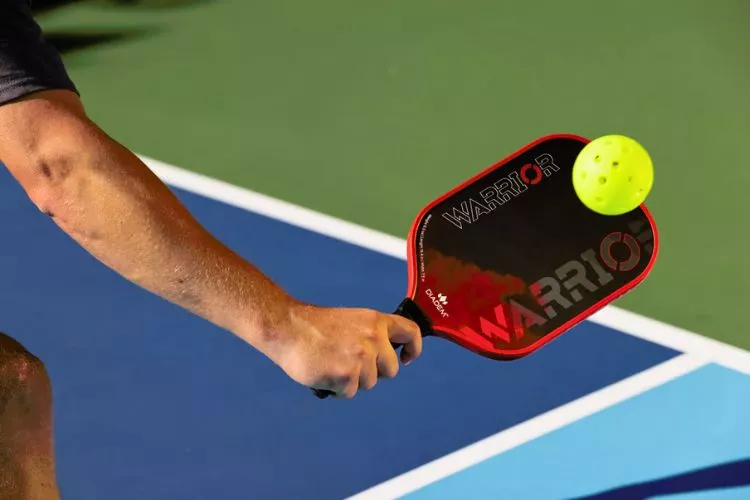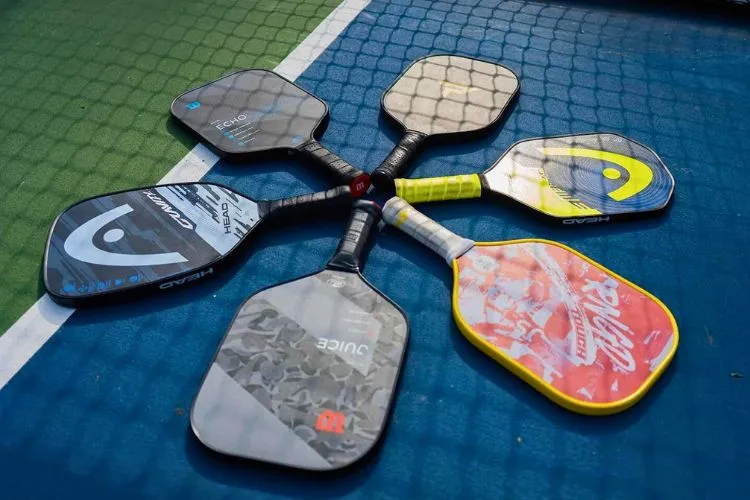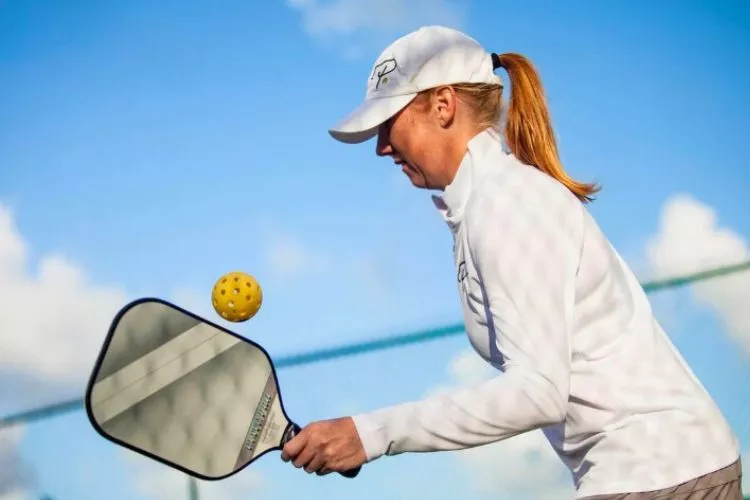In the popular and fast-paced sport of pickleball, the paddle is the most critical piece of equipment. However, one often wonders: “How long does pickleball paddle last?”

This comprehensive article provides insights into the lifespan of pickleball paddles, diving into factors such as materials used, maintenance practices, and normal wear and tear.
Whether you’re an avid player keen on extending your paddle’s lifespan or a beginner choosing your first paddle, understanding this durability aspect is crucial for a seamless pickleball experience.
How long does pickleball paddle last?
The lifespan of a pickleball paddle primarily depends on three factors: the quality of the materials, the frequency of usage, and the way it’s maintained. High-quality paddles, often made from graphite or composite materials, can last anywhere from 1-5 years with regular use.
On the flip side, a wooden or lesser-quality paddle may have a lifespan of 6 months to a year. For frequent players who use their paddles multiple times a week, the lifespan can be on the lower end of this range. However, if a paddle is only used occasionally, it can last several years.
Taking care of your paddle by not exposing it to harsh environments, cleaning it regularly, and storing it properly can significantly extend its life. In essence, a pickleball paddle can last for a considerable period, but its longevity is largely contingent on its quality, use, and care provided.
How do I make my pickleball paddle last longer?
Maintaining your pickleball paddle and taking actionable steps to ensure its longevity can significantly extend its usable lifespan. Here’s a comprehensive guide on making your paddle last longer:

- Avoid Impact: Avoid dropping or hitting the paddle against hard surfaces. Any major impact can cause damage to the paddle’s core, resulting in a decrease in performance.
- Use Paddle Covers: Always store your paddle in a cover or case when not in use. This reduces the risk of scratches, dents, and other damage.
- Clean Regularly: Dust and dirt can eventually degrade the surface of your paddle. To clean it, use mild soap and warm water, gently wiping the surface, ensuring you rinse thoroughly, and dry carefully afterward.
- Avoid Extreme Weather Conditions: Prolonged exposure to extreme weather (high temperatures, cold, or humidity) can degrade the materials. If possible, avoid playing in extreme weather, and never leave your paddle in car during summer or winter.
- Handle with Care: Always handle your paddle by its handle. By avoiding direct contact with the playing surface, you minimize the risk of any surface damage.
- Regularly Check Edge Guard: The edge guard can take a brunt of the impact during play. Keep an eye on it, and consider re-securing or replacing it if it begins to loosen or show damage.
- Maintain the Grip: Regularly check the grip for fraying or wear. Re-wrap or replace it when it begins to break down, as a good grip not only enhances your playing performance, but also avoids unnecessary stress on the paddle during hits.
- Rotate Paddles (if possible): If you play often, consider rotating between two or more paddles. This will allow each paddle to rest and recover from the rigors of play.
- Avoid Overhead Smashes: Overhead slams put a lot of strain on the paddle. While a spectacular shot to execute, doing it too often might cause premature failure of the paddle.
By following these steps, you will greatly enhance the lifespan of your paddle, saving you money in the long run and ensuring a far more effective play each time you hit the court.
How do you know when a pickleball paddle is worn out?
Recognizing the signs of a worn-out pickleball paddle is essential for maintaining optimal performance on the court. A paddle’s condition significantly impacts its effectiveness, and knowing when to replace it can be crucial. Here are several telltale signs that your pickleball paddle is worn out:

- Surface Damage: Examine the playing surface of the paddle for cracks, dents, or peeling layers. A damaged surface is prone to affecting the quality and accuracy of your shots. You might also find that paint is chipping off or that graphics are fading due to wear and tear.
- Edge Guard Issues: Check the edge guard, the bumper surrounding the paddle’s perimeter, for cracks, separation, or excessive peeling. A damaged edge guard can lead to playing surface damage or loss of structural integrity in the paddle.
- Handle Unraveling: Inspect the grip of your paddle for fraying, unraveling, or considerable wear. While grip can be replaced, a severely damaged handle might signal a more extensive issue with the paddle.
- Change in Sound: A well-functioning paddle produces a distinct sound when the ball makes contact. Listen for any changes; a dull, muted, or flat sound might be an indicator of internal damage or loosening of the core material.
- Decreased Responsiveness: Pay attention to the feel of the paddle in your hand. Are you experiencing a noticeable decline in performance – reduced power, spin, or response to your shots? This could be due to a worn-out paddle core or surface material.
- Weight Difference: Over time, internal core material can break down or degrade, leading to irregular weight distribution. If the paddle noticeably feels uneven or imbalanced from its original state, this could be a sign of wear.
- Loose Core: Press gently around the surface of the paddle to detect any soft spots, which can be a clear indication of core breakdown. Additionally, if you hear or feel any movement inside the paddle, this implies the core material has come loose, compromising its effectiveness.
If you observe any combination of these signs, it’s likely that your pickleball paddle is worn out, and it’s time to start considering a replacement.
You may also find useful: How Long Do Pickleball Shoes Last?
frequently asked questions (FAQs)
u003cstrongu003eHow many games does a pickleball paddle last?u003c/strongu003e
The number of games a pickleball paddle lasts before needing replacement depends largely on its build quality and how frequently it’s used. High-quality paddles can withstand approximately 1,000-1,500 games before demonstrating signs of significant wear. Lower quality or wooden paddles may last only around 500-700 games. However, remember that these numbers are approximate, as maintenance, care, and playing style all contribute to a paddle’s lifespan.
u003cstrongu003eWhen should paddles be replaced?u003c/strongu003e
Paddles should be replaced when they show clear signs of wear and tear that impact your gameplay. Indicators may include surface damage such as cracks, dents or delamination; a loosening or damaged edge guard; a faded sound upon striking; or an obvious decline in the power or accuracy of the shots. If your paddle has soft spots or feels different in terms of weight balance, it may be time for a replacement.
u003cstrongu003eWhen should I upgrade my pickleball paddle?u003c/strongu003e
Upgrading your pickleball paddle is recommended when you’re ready to enhance your gameplay technique or when you outgrow your current paddle’s capabilities. Other reasons could be if you need a lighter or heavier paddle for better control or power, or if you wish to try a paddle with different materials to improve your performance. It’s crucial to consider your skill level, playing style, and comfort when deciding to upgrade.
Conclusion:
The lifespan of a pickleball paddle hinges on multiple factors, including the quality of its materials, playing frequency, and care extended towards it. A well-constructed and meticulously maintained paddle can last from 1 to 5 years, serving hundreds of games.
However, recognizing signs of wear and tear—surface damage, a compromised edge guard, or decreased performance—is critical. This ensures you can replace or upgrade at the right time, improving your gaming experience and performance.
By understanding paddle longevity, users can invest wisely and adapt their maintenance practices, thereby enhancing the lifespan of their pickleball equipment.

Pickleball’s more than a game to me—it’s a passion. I write, sharing its highs and lows, the thrills and the lessons. Some tales might draw you to the court, while others give a hint of the game’s magic. So, curious about my journey? Ready to dive deep into the world of pickleball with me? Let’s go.
